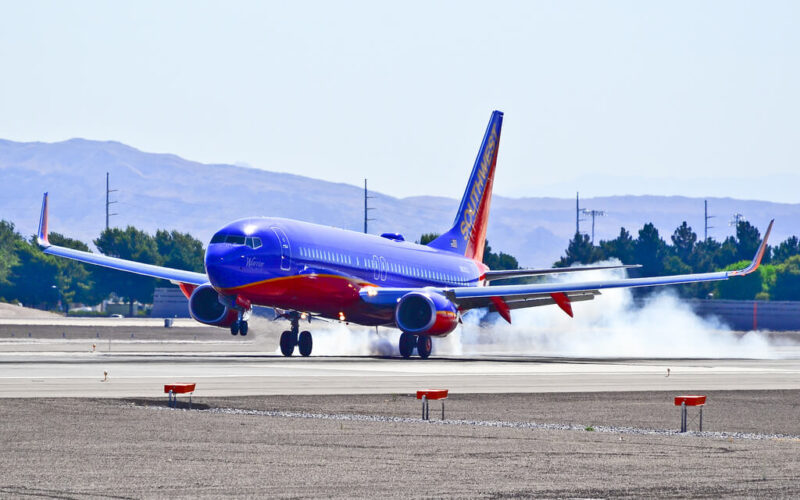Southwest has begun conducting test flights to Hawaii as it seeks regulatory approval to start its long-anticipated service to the popular travel destination. The airline carried out a one-time non-stop flight to Honolulu on February 5, 2019, using one of its Boeing 737s with plans to conduct a second flight the following day, and this time, passing the distance limit of its jetliners.
Southwest announced on February 5, 2019, it has successfully completed the first validation flight to Hawaii on one of its Boeing 737-800 jets. The flight took off from Oakland, California, and landed at Daniel K. Inouye International Airport (HNL) in Honolulu, marking Southwest’s very first touchdown in the Hawaiian Islands.
The test flight – with no passengers onboard – gave federal inspectors the opportunity to evaluate Southwest’s communication and navigation procedures during extended flights over water. It comes as part of the company’s authorization process with the U.S. Federal Aviation Administration (FAA) to be able to offer future scheduled service to Hawaii on its Boeing 737 twinjet, as the carrier puts it.
“Tomorrow’s validation flight is not a regular, scheduled flight and only FAA Representatives along with Southwest ETOPS Program Team Representatives and ETOPS-trained Southwest Pilots will be onboard to demonstrate our long range navigation and communication procedures and equipment,” Southwest spokesman Brian Parrish told USA Today’s Today in the Sky blog prior to the Oakland-Honolulu flight.
And the test flight itself would not be the finish line. According to Parrish, additional steps will be required to receive the necessary certification. Once that is achieved, Southwest plans to launch its first flights to Hawaii from California, with inter-island flights to begin sometime after.
You see that? That’s what it looks like when a Southwest bird lands in Hawaii!
Visit https://t.co/aOAa0lmiz7 to learn more about our plans to serve Hawaii. Stay tuned for more! pic.twitter.com/lbwT1CgQjr
— Southwest Airlines (@SouthwestAir) February 6, 2019
Southwest and back to mainland
Southwest’s efforts to secure the necessary ETOPS certification (Extended-range Twin-engine Operational Performance Standards) from the FAA have been hampered by the partial U.S. government shutdown. The carrier is believed to have been at the final stages of receiving regulatory approval at the time, expecting to complete the validation process by end of January 2019.
“Southwest is ready for next phases in our Extended Operations (ETOPS) application process: tabletop exercises and validation flights. Yet the groups within the FAA that oversee those activities are on furlough as a result of the lapse in agency funding, and our next steps require their direct participation and oversight,” a spokesman for the airline told AeroTime on January 17, 2019.
“We’re grateful to have received FAA approval of both our manuals and proposed procedures for ETOPS prior to the government shutdown, and we are ready to continue the ETOPS application process when the FAA is allowed to fully resume certification activities.”
But that’s not all.
Media reports on February 6 indicated Southwest was due to perform an even longer second non-stop test flight that day from Honolulu to Dallas Love Field Airport (DAL) in Texas, where the carrier is based.
Flight 8725 was to mark the return of the Boeing 737-800 that Southwest flew from Oakland, California, a day earlier. Despite initially planning a landing on the West Coast, the carrier had put its bets on “favorable tailwinds and a light aircraft load” for the return flight, which was scheduled to take six hours and 39 minutes, Bloomberg reports.
Although the success of the returning test flight has not been officially announced by Southwest, a spokesman for the airline confirmed to AeroTime on February 7, 2019, that the carrier completed the trip as planned: “Yesterday’s return flight from HNL to DAL (Southwest Flight #8725) was a long range navigation and communication validation flight … Due to favorable tailwinds and a light aircraft yesterday, conditions allowed us to fly the ETOPS 737-800 non-stop to our home at Love Field.”
The spokesman also noted the flight to Dallas “did not indicate any service intentions beyond those we’ve already announced”. Meaning, a repeat for the unusual flight is not likely.
Although not carrying any passengers, at almost 3,400 nautical miles the Honolulu-Dallas route would be up to 300 miles (approximately 483 km) past the 737-800’s normal range when filled with passengers, as Bloomberg points out (maximum range of the -800 variant is 3,115 nautical miles; the airliner is fitted with 162 seats in a two-class configuration).
As of end of last year, Southwest operated an all-Boeing fleet of 750 B737 airliners (average age of 11 years), the vast majority of them being the -700 variant and the remaining 207 being -800s and 31 MAX 8s. And in case you forgot, the carrier was the launch customer for the Boeing 737 MAX in the United States, taking delivery of its first Boeing 737 MAX 8 in August 2017.

